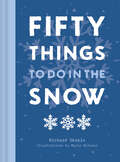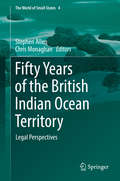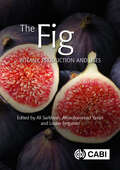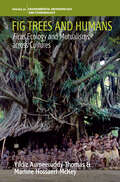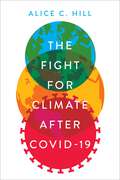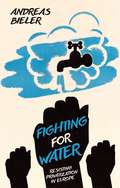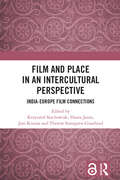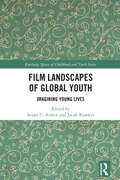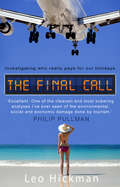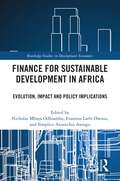- Table View
- List View
Fifty Things to Do in the Snow
by Richard SkreinIcy inspiration for playing, exploring and surviving in the snow. Don’t be put off by the cold – get out there and be dazzled by the wonder of winter. With fifty projects for having fun and staying safe in the snow, you’ll never be short of ideas.
Fifty Things to See in the Sky
by null Sarah BarkerA beautifully presented, practical gift guide to 50 sights in the skies above us. Explained with fascinating, easy-to-understand commentary from astrophysicist and science communicator, Sarah Barker, and illustrated throughout with captivating drawings by Maria Nilsson, each guide helps you locate an incredible sight. The book is divided into three main sections – and whether you use the naked eye, a telescope, or fall into a black hole of online research, you’ll discover the limitless wonder of the skies – from otherworldly phenomena on Earth like sun dogs, to planets, moons, stars, lunar craters and galaxy clusters. Naked Eye: Learn how navigators travelled in the past by finding the North Star; say hello to our astronauts and learn how to spot the International Space Station; see a red supergiant star (Betelgeuse); and find out more about solar eclipses. Further Afield: Find out more about the next closest galaxy, Andromeda; learn about the discovery of Saturn’s ‘ears’ (or rings!); spot an alien storm that’s as big as the Earth; and track ‘Little Green Men’ and ice volcanoes. Far, Far Away: Learn how baby stars are created by the Pillars of Creation; marvel at the Hubble Deep Field; and unearth the brightest things in our universe, quasars. The book also includes advice on ideal conditions for observing the stars, telescopes and binoculars, and navigating the skies. With extra tips and a rundown of useful tools, you’ll find everything you need to get out there and look up!
Fifty Years of the British Indian Ocean Territory: Legal Perspectives (The World of Small States #4)
by Stephen Allen Chris MonaghanThis book offers a detailed account of the legal issues concerning the British Indian Ocean Territory (Chagos Islands) by leading experts in the field. It examines the broader significance of the ongoing Bancoult litigation in the UK Courts, the Chagos Islanders' petition to the European Court of Human Rights and Mauritius' successful challenge, under the UN Convention of the Law of the Sea, to the UK government's creation of a Marine Protected Area around the Chagos Archipelago. This book, produced in response to the 50th anniversary of the BIOT's founding, also assesses the impact of the decisions taken in respect of the Territory against a wider background of decolonization while addressing important questions about the lawfulness of maintaining Overseas Territories in the post-colonial era.The chapter ‘Anachronistic As Colonial Remnants May Be...’ - Locating the Rights of the Chagos Islanders As A Case Study of the Operation of Human Rights Law in Colonial Territories is open access under a CC BY 4.0 license via link.springer.com.
The Fig: Botany, Production and Uses (Botany, Production and Uses)
by Mohammad Abdolahipour Fateh Aljane Azam Amiri Maria L Amodio Francisco C Balas Patrick Brown Zeinab Bolboli Anshul Chawla Pasqualina Colasuonno Giancarlo Colelli Neda Dalir Naser Davatgar Birgül Ertan Engin Ertan Louise Ferguson Giuseppe Ferrara Badii Gaaliche Ana I Galván A. J Galán Carlos A. Garza Jan H. Giliomee Phoebe Gordon Matthew J. Grieshop G Dalkiliç Günver Professor Jose Ignacio Hormaza Akihiro Hosomi Hidetoshi Ikegami Ali Akbar Kamgar-Haghighi Finn Kjellberg Moslem Jafari Zhihong Li Margarita López Corrales Mahshad Maghoumi Giuseppe Massimino Cocuzza Chabane Mazri Andrea Mazzeo Themis J. Michailides Reza Mostowfizadeh-Ghalamfarsa Diganta Narzary Mohamed H Neily Hitoshi Nogata Professor A Aytekin Polat Asghar Ramezanian Jean-Yves Rasplus Maria G.F. Rodrigues Sead Sabanadzovic Rajwinder K. Sandhu Manuel Joaquín Serradilla Sánchez Zeinab Shokoohi Federica Spagnoli Vassilio Stournaras Mohammad H. Tarazkar Dr Ioannis Tzanetakis Simon Van Noort Alimohammad Yavari Hiroshi Yakushiji Yue Zhang Megan Crivelli Tatjana K Kokaj Souhila Mahmoudi Ilaria MarcotuliThe common fig Ficus carica L. is an ancient fruit native to the Mediterranean. Dried figs have been successfully produced and processed in arid regions with little sophisticated infrastructure for centuries. Figs are rich in fibre, trace minerals, polyphenols and vitamins, with higher nutrient levels than most fruits. Advances in agricultural production and postharvest technologies have not only improved the efficiency of dried fig production but have facilitated the development of high value fresh fig industries both for export and domestic markets. The result is high quality fresh figs that are marketed internationally throughout the year. This book provides a comprehensive summary of fig growing, processing and marketing from a scientific and horticultural perspective. It is comprised of 19 chapters that include in-depth discussions of: History of fig cultivation; Physiology; Breeding and cultivars; Propagation; Site selection and orchard establishment; Nutrition and irrigation management; Pollination management; Integrated pest management; Greenhouse production; Harvesting, dried and fresh fig processing; The medicinal uses of figs; and World fig markets. The Fig: Botany, Production and Uses is a comprehensive applied resource for academic researchers, as well as producers, processors, and marketers of dried and fresh figs.
Fig Trees and Humans: Ficus Ecology and Mutualisms across Cultures (Environmental Anthropology and Ethnobiology #32)
by Yildiz Aumeeruddy-Thomas Martine Hossaert-McKeyHumans and figs form hybrid communities within the context of anthropogenic landscapes, supported by biocultural mutualisms driven by traits of Ficus species and people’s imagination and practices, and where humans also positively influence Ficus species ecology. Fig Trees and Humans examines the interactions between the biology and ecology of the genus Ficus and how humans use and think of Ficus species across the tropics and in the Mediterranean region. It demonstrates a high level of convergence of material and symbolic uses of human-fig interactions that affect various aspects of human culture, as well as the ecology of wild or cultivated Ficus species.
Fig Trees and Humans: Ficus Ecology and Mutualisms across Cultures (Environmental Anthropology and Ethnobiology #32)
by Yildiz Aumeeruddy-Thomas Martine Hossaert-McKeyHumans and figs form hybrid communities within the context of anthropogenic landscapes, supported by biocultural mutualisms driven by traits of Ficus species and people’s imagination and practices, and where humans also positively influence Ficus species ecology. Fig Trees and Humans examines the interactions between the biology and ecology of the genus Ficus and how humans use and think of Ficus species across the tropics and in the Mediterranean region. It demonstrates a high level of convergence of material and symbolic uses of human-fig interactions that affect various aspects of human culture, as well as the ecology of wild or cultivated Ficus species.
Fig Trees and Humans: Ficus Ecology and Mutualisms across Cultures (Environmental Anthropology and Ethnobiology #32)
by Yildiz Aumeeruddy-Thomas Martine Hossaert-McKeyHumans and figs form hybrid communities within the context of anthropogenic landscapes, supported by biocultural mutualisms driven by traits of Ficus species and people’s imagination and practices, and where humans also positively influence Ficus species ecology. Fig Trees and Humans examines the interactions between the biology and ecology of the genus Ficus and how humans use and think of Ficus species across the tropics and in the Mediterranean region. It demonstrates a high level of convergence of material and symbolic uses of human-fig interactions that affect various aspects of human culture, as well as the ecology of wild or cultivated Ficus species.
The Fight for Climate after COVID-19
by Alice C. HillCOVID-19 exposed the world's failure to prepare for the worst -- can we learn to build back better? The COVID-19 pandemic has hit our world on a scale beyond living memory, taking millions of lives and leading to a lockdown of communities worldwide. A pandemic, much like climate change, acts as a threat multiplier, increasing vulnerability to harm, economic impoverishment, and the breakdown of social systems. Even more concerning, communities severely impacted by the coronavirus still remain vulnerable to other types of hazards, such as those brought by accelerating climate change. The catastrophic risks of pandemics and climate change carry deep uncertainty as to when they will occur, how they will unfold, and how much damage they will do. The most important question is how we can face these risks to minimize them most. The Fight for Climate after COVID-19 draws on the troubled and uneven COVID-19 experience to illustrate the critical need to ramp up resilience rapidly and effectively on a global scale. After years of working alongside public health and resilience experts crafting policy to build both pandemic and climate change preparedness, Alice C. Hill exposes parallels between the underutilized measures that governments should have taken to contain the spread of COVID-19 -- such as early action, cross-border planning, and bolstering emergency preparation -- and the steps leaders can take now to mitigate the impacts of climate change. Through practical analyses of current policy and thoughtful guidance for successful climate adaptation, The Fight for Climate after COVID-19 reveals that, just as our society has transformed itself to meet the challenge of coronavirus, so too will we need to adapt our thinking and our policies to combat the ever-increasing threat of climate change. Unapologetic and clear-eyed, The Fight for Climate after COVID-19 helps us understand why the time has come to prepare for the world as it will be, rather than as it once was.
The Fight for Climate after COVID-19
by Alice C. HillCOVID-19 exposed the world's failure to prepare for the worst -- can we learn to build back better? The COVID-19 pandemic has hit our world on a scale beyond living memory, taking millions of lives and leading to a lockdown of communities worldwide. A pandemic, much like climate change, acts as a threat multiplier, increasing vulnerability to harm, economic impoverishment, and the breakdown of social systems. Even more concerning, communities severely impacted by the coronavirus still remain vulnerable to other types of hazards, such as those brought by accelerating climate change. The catastrophic risks of pandemics and climate change carry deep uncertainty as to when they will occur, how they will unfold, and how much damage they will do. The most important question is how we can face these risks to minimize them most. The Fight for Climate after COVID-19 draws on the troubled and uneven COVID-19 experience to illustrate the critical need to ramp up resilience rapidly and effectively on a global scale. After years of working alongside public health and resilience experts crafting policy to build both pandemic and climate change preparedness, Alice C. Hill exposes parallels between the underutilized measures that governments should have taken to contain the spread of COVID-19 -- such as early action, cross-border planning, and bolstering emergency preparation -- and the steps leaders can take now to mitigate the impacts of climate change. Through practical analyses of current policy and thoughtful guidance for successful climate adaptation, The Fight for Climate after COVID-19 reveals that, just as our society has transformed itself to meet the challenge of coronavirus, so too will we need to adapt our thinking and our policies to combat the ever-increasing threat of climate change. Unapologetic and clear-eyed, The Fight for Climate after COVID-19 helps us understand why the time has come to prepare for the world as it will be, rather than as it once was.
Fighting for Farming Justice: Diversity, Food Access and the USDA (Earthscan Food and Agriculture)
by Terri R. JettThis book provides a detailed discussion of four class-action discrimination cases that have recently been settled within the United States Department of Agriculture (USDA) and have led to a change in the way in which the USDA supports farmers from diverse backgrounds. These settlements shed light on why access to successful farming has been so often limited to white men and/or families, and significantly this has led to a change for opportunities in the way the USDA supports famers from diverse backgrounds. With chapters focusing on each settlement Jett provides an overview of the USDA before diving into a closer discussion of the four key settlements, involving African American farmers (Pigford), Native Americans (Keepseagle), Woman famers (Love) and Latino(a) farmers (Garcia), and the similarities between each. This title places and emphasis on what is happening in farming culture today, drawing connections between these four settlements and the increasing attention on urban farming, community gardens, farmers markets, organic farming and the slow food movement, through to the larger issues of food justice and access to food. Fighting for Farming Justice will be of interest to scholars of food justice and the farming arena, as well as those in the fields of Agricultural Economics, Civil Rights Law and Ethic Studies.
Fighting for Farming Justice: Diversity, Food Access and the USDA (Earthscan Food and Agriculture)
by Terri R. JettThis book provides a detailed discussion of four class-action discrimination cases that have recently been settled within the United States Department of Agriculture (USDA) and have led to a change in the way in which the USDA supports farmers from diverse backgrounds. These settlements shed light on why access to successful farming has been so often limited to white men and/or families, and significantly this has led to a change for opportunities in the way the USDA supports famers from diverse backgrounds. With chapters focusing on each settlement Jett provides an overview of the USDA before diving into a closer discussion of the four key settlements, involving African American farmers (Pigford), Native Americans (Keepseagle), Woman famers (Love) and Latino(a) farmers (Garcia), and the similarities between each. This title places and emphasis on what is happening in farming culture today, drawing connections between these four settlements and the increasing attention on urban farming, community gardens, farmers markets, organic farming and the slow food movement, through to the larger issues of food justice and access to food. Fighting for Farming Justice will be of interest to scholars of food justice and the farming arena, as well as those in the fields of Agricultural Economics, Civil Rights Law and Ethic Studies.
Fighting for Water: Resisting Privatization in Europe
by Andreas BielerIn the wake of the global financial crisis, water services have come under renewed neoliberal assault across Europe. At the same time, the struggle against water privatization has continued to pick up pace; from the re-municipalization of water in Grenoble in 2000, to the United Nations declaration of water as a human right in 2010.In Fighting for Water, Andreas Bieler draws on years of extensive fieldwork to dissect the underlying dynamics of the struggle for public water in Europe. By analysing the successful referendum against water privatization in Italy, the European Citizens' Initiative on 'Water and Sanitation are a Human Right', the struggles against water privatization in Greece and water charges in Ireland, Bieler shows why water has been a fruitful arena for resistance against neoliberal restructuring.
Fighting for Water: Resisting Privatization in Europe
by Andreas BielerIn the wake of the global financial crisis, water services have come under renewed neoliberal assault across Europe. At the same time, the struggle against water privatization has continued to pick up pace; from the re-municipalization of water in Grenoble in 2000, to the United Nations declaration of water as a human right in 2010.In Fighting for Water, Andreas Bieler draws on years of extensive fieldwork to dissect the underlying dynamics of the struggle for public water in Europe. By analysing the successful referendum against water privatization in Italy, the European Citizens' Initiative on 'Water and Sanitation are a Human Right', the struggles against water privatization in Greece and water charges in Ireland, Bieler shows why water has been a fruitful arena for resistance against neoliberal restructuring.
Film and Place in an Intercultural Perspective: India-Europe Film Connections
by Krzysztof Stachowiak Hania Janta Jani Kozina Therese Sunngren-GranlundThe book offers an interdisciplinary overview of the film and place relationship from an intercultural perspective. It explores the complex domain of place and space in cinema and the film industry's role in establishing cultural connections and economic cooperation between India and Europe.With contributions from leading international scholars, various case studies scrutinise European and Indian contexts, exploring both the established and emerging locations. The book extends the dominantly Britain-oriented focus on India’s cinema presence in Europe to European countries such as Italy, Switzerland, Poland, Slovenia, Finland, and Sweden, where the Indian film industry progressively expands its presence. The chapters of this book look at Indian film production in Europe as a cultural bridge between India and Europe, fostering mutual understanding of the culture and society of the two regions.This interdisciplinary book will be of interest to researchers in film studies, cultural anthropology, cultural geography, tourism, economics, sociology, and cultural studies. It will also be interest to practitioners working in local authorities, destination management, tourism, and creative business, all of whom see the value of film production in attracting visitors, investment, and creating new networks with local economic actors. The book offers much-needed data and tools to translate their professional goals and potentials into effective regional strategies and activities.
Film and Place in an Intercultural Perspective: India-Europe Film Connections
The book offers an interdisciplinary overview of the film and place relationship from an intercultural perspective. It explores the complex domain of place and space in cinema and the film industry's role in establishing cultural connections and economic cooperation between India and Europe.With contributions from leading international scholars, various case studies scrutinise European and Indian contexts, exploring both the established and emerging locations. The book extends the dominantly Britain-oriented focus on India’s cinema presence in Europe to European countries such as Italy, Switzerland, Poland, Slovenia, Finland, and Sweden, where the Indian film industry progressively expands its presence. The chapters of this book look at Indian film production in Europe as a cultural bridge between India and Europe, fostering mutual understanding of the culture and society of the two regions.This interdisciplinary book will be of interest to researchers in film studies, cultural anthropology, cultural geography, tourism, economics, sociology, and cultural studies. It will also be interest to practitioners working in local authorities, destination management, tourism, and creative business, all of whom see the value of film production in attracting visitors, investment, and creating new networks with local economic actors. The book offers much-needed data and tools to translate their professional goals and potentials into effective regional strategies and activities.
Film Landscapes of Global Youth: Imagining Young Lives (Routledge Spaces of Childhood and Youth Series)
by Stuart C. Aitken Jacob RowlettThis book explores the dynamic landscapes of global youth through spatially grounded chapters focused on film and media. It is a collection of incredible works concerning children and young people in, out, and through media as well as an examination of what is possible for the future of research within the intersections of geography, film theory, and children’s studies.It contains contributions from leading academics from anthropology, sociology, philosophy, art, film and media studies, women and gender studies, Indigenous studies, education, and geography, with chapters focused on a spatial area and the representations and relationships of children in that area through film and media. The insights presented also provide a unique and eclectic perspective on the current state of children’s research in relation to the ever-changing media landscape of the 21st century. Film Landscapes of Global Youth approaches the subjects of children and young people in film and media in a way that is not bound by genre, format, medium, or the on-/off-screen binary. Each chapter offers an insightful look at the relationships and portrayals of children and young people in relation to a specific country, culture, or geographic feature.This book is a must-read for anyone interested in the intersections between geography, young lives, and the power of film, television, social media, content creation, and more.
Film Landscapes of Global Youth: Imagining Young Lives (Routledge Spaces of Childhood and Youth Series)
This book explores the dynamic landscapes of global youth through spatially grounded chapters focused on film and media. It is a collection of incredible works concerning children and young people in, out, and through media as well as an examination of what is possible for the future of research within the intersections of geography, film theory, and children’s studies.It contains contributions from leading academics from anthropology, sociology, philosophy, art, film and media studies, women and gender studies, Indigenous studies, education, and geography, with chapters focused on a spatial area and the representations and relationships of children in that area through film and media. The insights presented also provide a unique and eclectic perspective on the current state of children’s research in relation to the ever-changing media landscape of the 21st century. Film Landscapes of Global Youth approaches the subjects of children and young people in film and media in a way that is not bound by genre, format, medium, or the on-/off-screen binary. Each chapter offers an insightful look at the relationships and portrayals of children and young people in relation to a specific country, culture, or geographic feature.This book is a must-read for anyone interested in the intersections between geography, young lives, and the power of film, television, social media, content creation, and more.
Filtering Techniques for Turbulent Flow Simulation (Lecture Notes in Engineering #56)
by Alvaro A. Aldama1. 1 Scope of the Study The detailed and reasonably accurate computation of large scale turbulent flows has become increasingly important in geophysical and engi neering applications in recent years. The definition of water quality management policies for reservoirs, lakes, estuaries, and coastal waters, as well as the design of cooling ponds and solar ponds, requires an ade quate quantitative description of turbulent flows. When the diffusion of some tracer (be it active, such as temperature or salinity, or passive, such as dissolved oxygen) is of relevance to a specific application, the proper determination of the effects of turbulent transport processes has paramount importance. Thus, for instance, the proper understanding of lake and reservoir dynamics requires, as a first step, the ability to simulate turbulent flows. Applications in other areas of geophysical research, such as meteorology and oceanography are easily identified and large in number. It should be stressed that, in this context, the analyst seeks predictive ability to a certain extent. Accordingly, the need for simulation models that closely resemble the natural processes to be repre sented has recently become more evident. Since the late 1960s considerable effort has been devoted to the development of models for the simulation of complex turbulent flows. This has resulted in the establishment of two approaches which have been, or 2 have the potential for being, applied to problems of engineering and geophysical interest.
The Final Call: Investigating Who Really Pays For Our Holidays
by Leo HickmanNo industry in the world employs more people or is the world's largest foreign currency earner than tourism. Long billed as the cleanest industry for developing countries to invest in, tourism seems to offer everyone involved a positive experience.This is the official line, anyway. In truth, the reality is much more complex . For The Final Call Hickman travels the world on a range of holidays and finds that behind the sunny facade of pools, smiling locals, sightseeing trips and exquisite cuisine is an ugly reality and it is spreading unchecked to all corners of the globe. But none of us are going to stop holidaying and at the heart of this is a heartfelt attempt to discover the best way to holiday wherever you are.
The Final Energy Crisis
by Sheila NewmanWith oil reaching $100 a barrel in January 2008 and the US facing challenges to dollar hegemony, few people would now deny that there is an energy crisis and that it is linked to economic uncertainty. However, the mainstream lacks a theory to explain this apparently sudden challenge to optimistic expectations of long-term economic growth and an end to world poverty. The Final Energy Crisis provides political explanations to fill that gap.*BR**BR*The authors engage with depletion trends in oil, gas, coal, uranium, soil and biodiversity. Taking an interdisciplinary approach, they study energy trends, prospects, assets and liabilities in different political systems and regions, including the US, Venezuela, China, Africa, the ex-Soviet Union, North Korea, Japan, France and Australia. Far from being a doom-laden work on peak oil, this book offers practical suggestions for readers keen to be part of the solution to resource depletion.*BR**BR*This comprehensively updated edition includes 13 new chapters and thorough revisions of existing material.
Finance and Sustainability: Proceedings from the Finance and Sustainability Conference, Wroclaw 2017 (Springer Proceedings in Business and Economics)
by Agnieszka Bem Karolina Daszyńska-Żygadło Taťána Hajdíková Péter JuhászThis volume covers the proceedings of the ZAFIN Finance and Sustainability conference, organized by the Wroclaw University of Economics in cooperation with the Corvinus University of Budapest and the University of Economics in Prague. The authors analyze a variety of issues related to recent finance problems, including corporate finance, public finance, monetary and fiscal policy issues, and risk management. The book also discusses topics related to sustainable finance, the transition to green economies, corporate sustainability and sustainable development. The target audience for this book includes researchers at universities and research and policy institutions, graduate students, and practitioners in economics, finance and international economics working for private or government institutions.
Finance and Sustainability: Proceedings from the 2nd Finance and Sustainability Conference, Wroclaw 2018 (Springer Proceedings in Business and Economics)
by Karolina Daszyńska-Żygadło Agnieszka Bem Bożena Ryszawska Erika Jáki Taťána HajdíkováThis volume presents the proceedings of the ZAFIN Finance and Sustainability conference, organized by the Wroclaw University of Economics in cooperation with Corvinus University of Budapest and the University of Economics in Prague. The contributing authors analyze a variety of issues concerning recent finance problems, including corporate finance, public finance, monetary and fiscal policy issues, and risk management. The book also addresses topics connected to sustainable finance, the transition to green economies, corporate sustainability and sustainable development. The target audience for this book includes researchers at universities and research and policy institutions, graduate students, and practitioners in economics and finance working for private or government institutions.
Finance for Sustainable Development in Africa: Evolution, Impact and Policy Implications (Routledge Studies in Development Economics)
by Nicholas Mbaya Odhiambo Erasmus Larbi Owusu Simplice Anutechia AsonguAlthough a number of selected African countries have made efforts to implement various financial sector reforms, many countries have not fully implemented the requisite reforms required for sustainable development. Instead, they have focused mainly on bank-based financial reforms, thereby neglecting market-based financial reforms. This study provides a one-stop shop for understanding the history and evolution of the financial sector in Africa with a special focus on the sub-Saharan region where the financial system in many countries is still at a relatively nascent stage. The analysis is extensive and robust, and starts from financial repression to financial liberalisation (both internal and external), and its role in sustainable development and poverty alleviation. The book covers a range of important research issues pertaining to financial development in selectede African countries, including interest rate and exchange rate reforms, the dynamics of bank-based and market-based financial development; the role of the informal financial sector in sustainable development; the finance-growth nexus; bank-based versus market-based financial sectors in Africa; financial development and information and communication technology; and financial development and gender equality, among other topics. The book also considers the relationship between the COVID-19 global pandemic and financial development, and concludes by presenting a forecast of the future trends of financial and sustainable development on the African continent in general and sub-Saharfan Africa in particular. The chapters are authored by prominent scholars and researchers in the field of finance and banking, applied econometrics and development economics, with a deep understanding and knowledge of financial development and the local situations in African countries. This book provides crucial reference material for academics, researchers, policymakers and students of all levels and is a must-read for anyone wishing to understand the nature of finance and sustainable development in Africa in relation to the rest of the world. It covers African countries, but with more emphasis on the sub-Saharan African region where the financial systems in many of the countries are still relatively underdeveloped.
Finance for Sustainable Development in Africa: Evolution, Impact and Policy Implications (Routledge Studies in Development Economics)
Although a number of selected African countries have made efforts to implement various financial sector reforms, many countries have not fully implemented the requisite reforms required for sustainable development. Instead, they have focused mainly on bank-based financial reforms, thereby neglecting market-based financial reforms. This study provides a one-stop shop for understanding the history and evolution of the financial sector in Africa with a special focus on the sub-Saharan region where the financial system in many countries is still at a relatively nascent stage. The analysis is extensive and robust, and starts from financial repression to financial liberalisation (both internal and external), and its role in sustainable development and poverty alleviation. The book covers a range of important research issues pertaining to financial development in selectede African countries, including interest rate and exchange rate reforms, the dynamics of bank-based and market-based financial development; the role of the informal financial sector in sustainable development; the finance-growth nexus; bank-based versus market-based financial sectors in Africa; financial development and information and communication technology; and financial development and gender equality, among other topics. The book also considers the relationship between the COVID-19 global pandemic and financial development, and concludes by presenting a forecast of the future trends of financial and sustainable development on the African continent in general and sub-Saharfan Africa in particular. The chapters are authored by prominent scholars and researchers in the field of finance and banking, applied econometrics and development economics, with a deep understanding and knowledge of financial development and the local situations in African countries. This book provides crucial reference material for academics, researchers, policymakers and students of all levels and is a must-read for anyone wishing to understand the nature of finance and sustainable development in Africa in relation to the rest of the world. It covers African countries, but with more emphasis on the sub-Saharan African region where the financial systems in many of the countries are still relatively underdeveloped.
Finance Policy for Renewable Energy and a Sustainable Environment
by Michael CurleyEnvironmental finance is about creating the greatest environmental benefit for the largest number of people at the lowest possible cost. That is the first and most important principle listed in Finance Policy for Renewable Energy and a Sustainable Environment. Focusing on what the author considers to be the 23 principles of environmental finance, t
